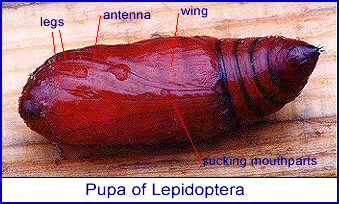Metamorphosis Brings on Many Changes

Butterflies love to "puddle". They congregate in areas of exposed wet soil, in this case on the edge of Dew Lake ( in the Chugach mountains just outside of Anchorage) and suck up the mineralized water. Butterflies belong to the Kingdom Animalia, Phylum Arthropoda, Class Insecta (or Hexapoda), and Order Lepidoptera, which literally means "scaly wings". Like many other animals, butterfly larvae hatch from eggs and go through a series of molts.
During a molt the butterfly larva, called a caterpillar, breaks out of its old skin, increases in size, and continues eating. The larva grows internally as well, and begins to develop some of the organs it will use as an adult, such as antennae and wings. These changes are internal and not readily visible. After five or six or more of these larval molts the caterpillar pupates.
During pupation, the larva hardens on the outside and detaches from its old skin on the inside . Pupation may occur inside a silk cocoon spun by the larva, or in a small underground chamber,or under the loose bark of a tree, or in some other protected location that shields the immobile and defenseless pupa. It is at this point that the incredible event known as metamorphosis occurs.
 Depending
on the degree of re-construction needed to produce an adult form, the larval
organs selectively liquefy and are eaten by plasmatocyte cells in the hemolymph
( insect blood). In this way nothing is wasted. Subsequently, new and different
adult organs are produced from "imaginal discs", clusters of embryonic
cells retained in an undifferentiated form by the larva. New muscles are
formed for jaws, legs, and wings. Newly formed compound eyes and antenna
require a much enlarged brain. New neuronal connections are made or rerouted
from larval ganglia. New mouth parts, gut and excretory organs are formed
to accomodate the adult diet, usually nectar from flowers. And new sex organs
are formed that were entirely absent in the larva.
Depending
on the degree of re-construction needed to produce an adult form, the larval
organs selectively liquefy and are eaten by plasmatocyte cells in the hemolymph
( insect blood). In this way nothing is wasted. Subsequently, new and different
adult organs are produced from "imaginal discs", clusters of embryonic
cells retained in an undifferentiated form by the larva. New muscles are
formed for jaws, legs, and wings. Newly formed compound eyes and antenna
require a much enlarged brain. New neuronal connections are made or rerouted
from larval ganglia. New mouth parts, gut and excretory organs are formed
to accomodate the adult diet, usually nectar from flowers. And new sex organs
are formed that were entirely absent in the larva.
The adult form, hardly recognizable from it's larval inception, nevertheless has the exact same genetic material as the larva. The processes that control genetic expression and morphogenesis have been intensively studied but many details are unknown. Various hormones, physiological "competence", and environmental conditions such as temperature and photoperiods are all important factors.
Some insects, such as grasshoppers, produce larval forms that are outwardly similar to the adult. Such insects are called hemimetabolus because they do not go through all the growth phases that characterize holometabolus insects. My description of metamorphosis in holometabolous insects is based on R.F. Chapman's The Insects: Structure and Function, 4th Ed. ©1998, Chapter 15, "Postembryonic development".